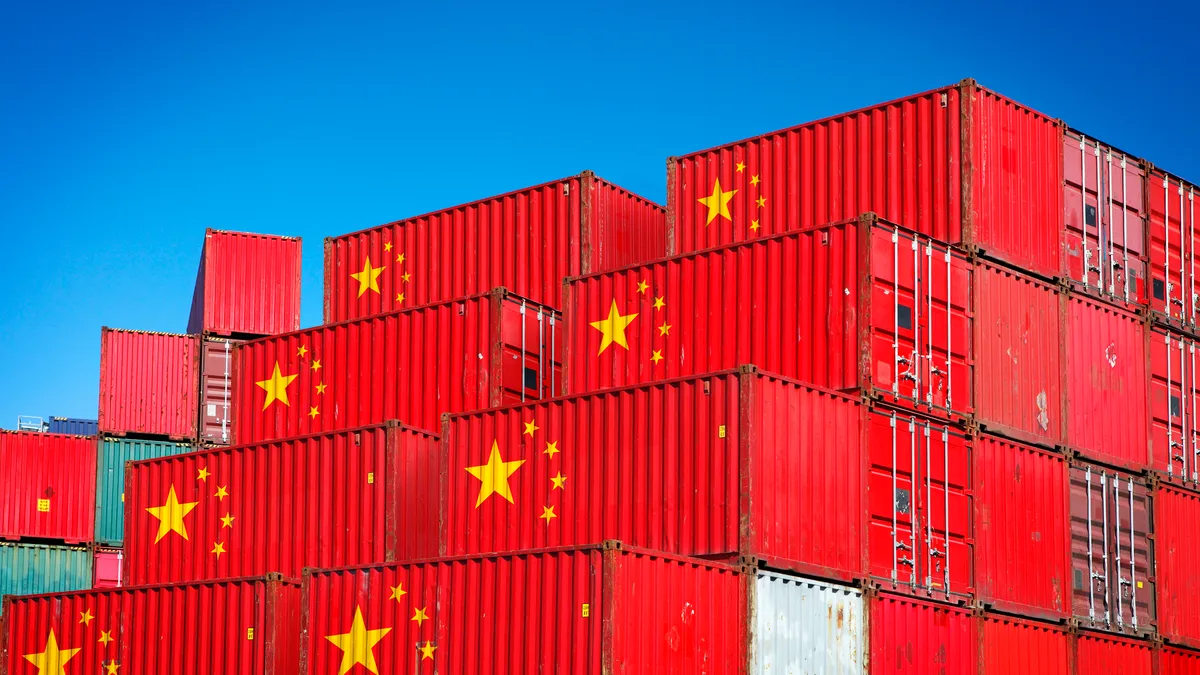UPDATE: May 8, 2019: A document filed in the Federal Register Wednesday morning confirms tariffs on $200 billion worth of imports from China will rise from 10% to 25% on Friday, May 10 at 12:01 a.m. ET.
"In the most recent negotiations, China has chosen to retreat from specific commitments agreed to in earlier rounds. In light of the lack of progress in discussions with China, the President has directed the Trade Representative to increase the rate of additional duty to 25 percent," the document said.
The Office of the U.S. Trade Representative will also publish a separate notice outlining an exclusion process.
Dive Brief:
- U.S. Trade Representative Robert Lighthizer confirmed 10% tariffs on $200 billion worth of Chinese imports will rise to 25% at 12:01 a.m. Eastern Standard Time on Friday, according to multiple news reports. His remarks follow a Sunday afternoon pair of tweets from President Donald Trump stating the existing tariffs will rise and new ones could be coming. The Office of the U.S. Trade Representative (USTR) has yet to issue a formal statement announcing the increase.
- Lighthizer cited an "erosion in commitments by China" and said the country retreated from earlier commitments it had made in the negotiations. In the same press conference, Treasury Secretary Steve Mnuchin said the U.S. would reconsider the tariff increase if trade talks get back on track, CNBC reported.
- A Chinese delegation was scheduled to travel to the U.S. this week for trade discussions. The Chinese Commerce Ministry said Liu He, China's Vice Premier, is still scheduled to travel to Washington but did not specify what topics would be discussed, according to Reuters.
Dive Insight:
Trump's Sunday tweets brought the more than five-month trade truce between the U.S. and China to a grinding halt. The sudden news came as a seemingly 180-degree turn from recent rhetoric surrounding trade talks, which Trump administration officials had described as "constructive" and "productive."
Less than a week's notice on a tariff increase leaves companies with little to no time to adjust their supply chains to mitigate the financial burden, though in reality companies have been planning for the possibility of a hike to 25% since it was suggested last year.
For some, that means shifting sourcing away from China. Brooks Running, owned by Warren Buffett, said it will move the majority of its running shoe production out of China and to Vietnam, Reuters reported.
Moving sourcing comes with a new set of risks, however. "Workers in countries such as Bangladesh, Cambodia and Vietnam are at more risk than in China across a wide number of issues," Ryan Aherin, head of commodity service for Verisk Maplecroft, wrote in a risk outlook emailed to Supply Chain Dive.
While China is far from risk-free on labor and social rights issues, it's a "well-trodden" path companies have become accustomed to navigating, according to Aherin. "Taking the less trodden path could prove to be more perilous than staying put," he wrote.
The initial announcement of 25% tariffs brought a rush to import goods in the last few months of 2018, and it's possible the news from the Trump administration could result in another rush, though likely for air freight as it's only the method shippers can use to bring goods in before Friday morning.
"Importers are more focused than ever on cost efficiency as the 2019 peak shipping season approaches," Lori Fox, vice president of customs brokerage services at American Global Logistics, told Supply Chain Dive in an emailed statement.
Shippers would have to weigh the cost of air freight with the cost of paying 25% duties to assess the most cost-effective method.
For cargo already in transit by ocean freight, shippers may have no choice but to pay 25% tariffs once the shipments arrive in the U.S.
Correction: Verisk Maplecroft previously misidentified the name of its head of commodity service.














